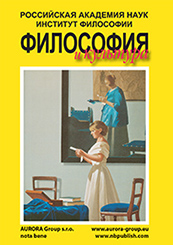Editor-in-Chief's column
Reference:
Gurevich P.S. (2017). Nietzsche about the lust for power. Philosophy and Culture, 1, 11–14. https://en.nbpublish.com/library_read_article.php?id=68427
Abstract:
This article is dedicated to analysis of the phenomenon of power and lust for power in F. Nietzsche philosophical heritage. The German thinker spoke from the perspective of the philosophy of life. He believed that the excessive dedication to rationality has hurt the European humanity. Representative of this direction attempted to understand life from itself. They advocated on the side of feelings and instinct. Nietzsche wanted to make his book “Will to Power” a programmatic work. But he left just a number of notes and aphorisms, which formed in the course of preparation of the book to completion. However, the combination of sparse notes reveals an explicit cognition of such complicated phenomenon as power. All of the existing human knowledge as a whole is the determination of will to power. The article is firs within the Russian philosophical literature to make an attempt of interpretation of Nietzsche’s views upon power in form of a specific field of his heritage. Nietzsche claimed that will to power can be examines as human basic instinct, but at the same time was looking for opportunity to explain the lust for power as a need, feeling, and passion. In philosopher’s interpretation of passion, we can notice strive for differentiation of this phenomenon from instinct. Interpretation of the tyranny of spirit particularized, and as a final accord of this reasoning about power, Nietzsche names it a demon. It is the universal passion that used by the politicians for consolidation of despotism. The article presents a distinct phenomenology of power.
Keywords:
Punishment, Subordination, Domination, Tyranny of spirit, Demonism, Feeling, Passion, Lust for power, Instinct, Power
Tradition and innovation
Reference:
Tolstykh I.N., Metlyaeva T.V. (2017). Ritual dance in the context of China’s religious and cultural traditions. Philosophy and Culture, 1, 15–24. https://en.nbpublish.com/library_read_article.php?id=68529
Abstract:
This article attempts to examine the impact of the religious and cultural traditions of China upon the development of ritual dance, which is popular not only among the Chinese population, but also Russian-speaking diaspora of China and residents of the bordering Russian regions. The dance remains to be in epicenter of China’s cultural life, connecting its modernity with the deep antiquity. Due to the fact that religion and cultural traditions are the foundation for understanding the general philosophy and regularities of development of the entire Chinese culture, the object of this research is the impact of the religious and cultural traditions upon the development of ritual dance in China. During the course of this research the authors set the following tasks: determine the specific features and peculiarities of the dance in various religious traditions of China; examine the dialectics of the dance culture; detect the typical features and peculiarities of the ritual-cult and functional dance; as well as analyze the usual and unusual of the ritual dance in the context of China’s religious and cultural traditions. The conclusion is made that the constant fusion and borrowing does not allow clearly demarcate, which of the dance phenomena belongs to one or another ethnic group. The authors also note that none of the religious directions that replaced each other in China, did not scratch the dance out of system of interaction between human and religion. Originated in Shamanism symbols and ritual action along with the mythological component of the religious life of society, established in Taoism and Buddhism, were harmoniously intertwined into the dance culture of the Chinese people. While the ethnical views of Confucianism that became the foundation of the government system, are the basic platform of dance art of Chine in general.
Keywords:
Buddhism, Shamanism, Custom, Ritual, Dance, Tradition, Views, Religion, People, Chinese culture
History of ideas and teachings
Reference:
Lutsenko V.E. (2017). The doctrine of Maine de Biran about the origin and nature of our cognition. Philosophy and Culture, 1, 25–29. https://en.nbpublish.com/library_read_article.php?id=68428
Abstract:
The object of this research is the philosophical doctrine of French thinker of the early XIX century – Maine de Biran. The subject of the study is the views of the French philosopher on the origin and nature of human cognition. The author analyzes the works of Maine de Biran, dedicated to the origin and nature of our cognition. Arguing that the only person is capable of understanding itself, and through itself and all that surrounds it. Maine de Biran takes the idea of freedom, which is identical to the philosopher the idea of power and strength. The methodological basis of the study is the scientific methods of analysis and synthesis, as well as phenomenological, bibliography and comparative-historical research methods. The author's special contribution into this work consists in the analysis of the major works of French and Russian philosophers of the early XIX century: Maine de Biran, Adolf Frank, A. I. Vvedenskiy, as well as the translation and analysis of works of the French scholar that have yet to be published.
Keywords:
human essence, true activity, freedom, phenomenon, effort of will, cognitive processes, philosophical mysticism, spiritualism, spiritual life, psychological nature
Philosophy of science
Reference:
Kuleshov A.V. (2017). Francis Bradley’s metaphysics and limits of scientific knowledge. Philosophy and Culture, 1, 30–39. https://en.nbpublish.com/library_read_article.php?id=68573
Abstract:
The subject of this research is the metaphysics of the English philosopher of the late XIX – early XX century Francis Bradley. The author examines the relation between metaphysical and special scientific knowledge within the framework of Bradley’s doctrine, particularly the crucial differences between metaphysics and science, which are based on the inherent to Bradley dichotomy of the visual and real, partial and whole, controversial and certain. The concept of the English philosopher correlates with the contemporary trends in development of special sciences and their attempts to create the final, all-encompassing scientific theory, formulate the ultimate explanation of reality. The article subjects to analysis the fundamental metaphysical and logical works of Francis Bradley, as well as the modern scientific and philosophical texts. The conclusion is made that in Bradley’s system, metaphysics plays the role of knowledge that approaches towards the adequate image of the Absolute reality. Special science are capable of expressing the incomplete truths, which are fairly productive within the boundaries of partial cognition of the reality. The attempts to overcome this limitation and solve metaphysical questions using the scientific means, determine the visible, partial, and controversial nature of the scientific knowledge. The provided in the article assessment of the trends in development of modern science underlines the legitimacy of limitations applied by metaphysics of F. Bradley upon the scientific knowledge. The author suggest an alternative to characteristic to Bradley understanding principle of determination of the subject of metaphysics.
Keywords:
contradiction, integrity, partiality, appearance, reality, absolute idealism, certainty, science, limit of scientific knowledge
Social philosophy
Reference:
Artemenko A.P. (2017). Text or palimpsest of the city?. Philosophy and Culture, 1, 40–46. https://en.nbpublish.com/library_read_article.php?id=68574
Abstract:
The subject of this research is the analysis of methodological approaches towards examination of the urban space. The goal of this work consists in development of the methodological complex that combines various angles of the review and approaches towards explanation of the phenomenon of city. Special attention is given to the concept of topos, idea of the contingency of space, analysis of the notion of “objectness”, which form the foundation of the topology of urban space. The city is presented as a derivative of sustainable multiplicities and relation networks. The author suggest the original concept of “palimpsest of the urban space”. The process of “erasing” physical objects of the city leads to the changes in the associated with them processes and projections. Application of the new text does not always thoroughly cover up the previous inscriptions, compelling to read the extruding text. The flatness attains the depth, and combination of the prospects becomes a vital demand. The conclusion is made that the urban space possesses the characteristic of the objectness, which is the correlation of the dynamic objects. The author determines the types of palimpsest: civilizational palimpsest; palimpsests of the ethnically controversial territories; and palimpsest of the previous capital.
Keywords:
topos, objectness, text, palimpsest, Actor-Network Theory, urban space, city, urban study, topology, contingency
Political philosophy
Reference:
Goncharov V.V., Poyarkov S.Yu. (2017). Human rights and freedoms as the ideal value of modern state. Philosophy and Culture, 1, 47–50. https://en.nbpublish.com/library_read_article.php?id=68575
Abstract:
This article is dedicated to examination of the rights and freedoms of an individual as the ideal values of the modern state. The work substantiates the position that human rights as a universal category serve as a significant dominant in development of civil society alongside the counterforce of absolutization of political power of the state in the process of establishment of constitutionalism. Rights and freedoms are the ideal value of any modern democratic state; because firstly, a person represents the highest value of social development, and, secondly, the purposes of existence and functionality of the government apparatus itself. Thus, the recognition, consolidation in the existing legislation (primarily the Constitution), adherence to and protection of the rights and freedoms of man and citizen, on one hand – is the cornerstone of formation and functionality of the government apparatus in modern democratic state as; and on the other hand – one of the main goals and tasks of the state.
Keywords:
democracy, Constitution, people, modern state, ideal value, citizen, man, freedom, law, government
Characteristics of society
Reference:
Pak E.G. (2017). On the role of culture in “South Korea’s economic miracle”: socio-philosophical analysis. Philosophy and Culture, 1, 51–56. https://en.nbpublish.com/library_read_article.php?id=68576
Abstract:
The subject of this research is the role of culture in emergence of the “South Korea’s economic miracle”, which can be viewed as rapid change in the economic sphere of social life during the process of modernization of society. M. Weber, whose research laid foundation for the cultural determinism, signified the impact of culture upon the economic activity of society in the beginning of the XX century. However, by the end of the century it became evident that endowing culture with special role in the process of modernization of society, distorts the picture of the reality. The concept of R. Inglehart on the complementary nature of correlations between the various spheres of social life comprises the methodology of this work. Examination of “South Korea’s economic miracle” confirms the relevance of the proposed theory, demonstrating how within the specific historical period, all of the spheres of social life (economic, political, social, and spiritual) interacted, complemented, and enriched each other, which led to the emergence of the aforementioned phenomenon.
Keywords:
Confucianism, mentality, religion, culture, politics, nation, economic miracle, South Korea, modernization, Christianity
Philosophy of history
Reference:
Senyutkin K.V. (2017). Value orientations in views of Chaadaev upon Russia’s historical fate. Philosophy and Culture, 1, 57–66. https://en.nbpublish.com/library_read_article.php?id=68577
Abstract:
This article attempts to analyze the genesis of the Russian thinker P. Y. Chaadaev, as well as antinomy of his views upon the historical fate and mission of Russia in the global cultural-historical process. The author analyzes the process of reevaluation on the brink of the two latest centuries, and ways of overcoming and exit from this systemic crisis. The subject of this work is Chaadaev’s outlook upon the fate of Russia, humanity, and Christianity in their assemblage, development, and transformation that were studied in close relation with the history of spiritual and intellectual establishment of the thought. The scientific novelty consists in the fact that this work represents a special research of Chaadaev’s views upon the fate of Russia, in which his ideas are examined in combination, development, and transformation based on his well-known publications in tight connection with his spiritual and intellectual formation. Russian thinkers is studied not from the perspective of a representative of particular sociopolitical doctrine, but rather an “living” person with independent ideologies, who completely dedicates himself to cognition of this world, and repeatedly but sincerely changes his point of view upon the historical designation of Russia and Orthodoxy.
Keywords:
Religion, Tradition, Values, Nihilism, Catholicism, Orthodoxy, Providentialism, West, Russia, P. Y. Chaadaev
Meaning and silence
Reference:
Danilova O.V. (2017). Theatrical existentialism of Marty Clément (Bartabas): fiction or philosophical view of the contemporary production director. Philosophy and Culture, 1, 67–76. https://en.nbpublish.com/library_read_article.php?id=68578
Abstract:
The subject of this research is the nontraditional theatrical-staged form of production of the spectacles of the French equestrian theatre “Zingaro”. Its originality consists in the fact that psychedelic distraction from one realty forms a different – atmospheric-association reality. This happens through the creation of audiovisual plastic-demonstrative mises-en-scène (placing on stage), which do not have a direct cause-and-effect relation, as it is common to the traditional production. The logic of narration of the plot is formed by the virtue of theoretical sequence of the precisely selected associations, caused by the action-plastic character of structuring the mises-en-scène. Namely them provide an opportunity for this demonstrative-staged theatrical form to transform the Reality. Such transformation changes the perception itself. This is a philosophical-psychological theatre. During the demonstration of “Zingaro” perforamces emerges a steady (associative) connection with subconsciousness of a spectator, which uses the potential of human mind to finishing (gestalt) of the incomplete images, theoretically shapes the chain of storyline and action collisions (mises-en-scène) into a certain logically proven notional concept that forms the imagery-artistic wholeness (completion) of a theatrical oeuvre and the corresponding structure (sequence) of its perception. It would be appropriate to pursue analogy with teleportation (in sense of the form of certain psychological effect), which serves as a conductor into the “world of recalls”. Thus, the audience is able to journey into the psycho-emotional essence of the “imaginary” reality. The Reality is viewed through the projection of “existence” in a completely new, and earlier uncharacteristic to it, perspective.
Keywords:
Archetype model, Religious existentialism, Theatrical performance, Situational-action modulation, Existential-psychoemotional abstraction, Demonstrative-action line, Imagery-conceptual context, Atmospheric-associative reality, Dramaturgical modelling of associations, Staged-demonstrative form
Mysteries of the human being
Reference:
Volkov D.B. (2017). The contemporary substantive approach towards the question of oneness of identity. Philosophy and Culture, 1, 77–85. https://en.nbpublish.com/library_read_article.php?id=68579
Abstract:
The object of this research is the contemporary philosophical discourse regarding the question of oneness of identity. The subject of this research is R. Swinburne’s substantive approach and its place within this discourse. The author analyzes Swinburne’s approach, and particularly its key advantages – ability to resolve the issue of reduplication of identity. However, the author demonstrates that the substantive approach also has certain vulnerabilities. First of all, it is susceptible to criticism with the help of the verification principle. Swinburne believes that his approach does not correspond with the strong version of verification principle. But as illustrated in the article, even the weak version of verification principle is an issue for the substantive approach of Swinburne. The author presents his original alternative to the substantive approach for the purpose of overcoming the argument of reduplication and interpretation of the associated with it hypothetical situations. Such alternative is the perdurance theory of identity. The article provides research in the area of history of the modern analytical philosophy, thus uses the historical-philosophical method as the key one. The work is dedicated to the substantial concept of Swinburne’s. Despite the fact that his concept represents an important alternative for resolution of the issue of the oneness of identity, it remains little-studied, especially within the Russian history of philosophy. The scientific novelty consists in a comprehensive analysis of the counterargument of verification pertaining to the substantive approach. The author concludes that the substantive approach is able to solve the issue of the asynchronous oneness of identity just partially, and most susceptible to criticism using the argument of verification.
Keywords:
Reduplication argument, Verification principle, David Parfit, Bill Williams, Richard Swinburne, Substantive approach, Physical approach, Psychological approach, oneness of identity, Empiricist theories
Aesthetics
Reference:
Fetisova E.E. (2017). The works of I. Lisnyanskaya in the concext of neo-Acmeism. Philosophy and Culture, 1, 86–97. https://en.nbpublish.com/library_read_article.php?id=68580
Abstract:
This article, based on separate examples, illustrates the distinctive features of I. Lisnyanskaya lyrical perception of the world – a neo-Acmeist “sixtier” – in intertextual communication with the traditional (classical) Acmeism, poetry of A. Akhmatova and M. Tsvetaeva, as well as the culture of European Renaissance. The author determines the foundation, concept, and “semantic poetics” of neo-Acmeism alongside its specific mythology, which in turn, structures a poetic model of the world. The article analyzes the spatial and time continuum, its coordinates, artistic space and time as a peculiar aesthetics and verbal phenomenon. The notion of synchronic-reminiscent chronotope, shifted relatively to the boundaries of the actual space and time, is being introduced; and thanks to this, the “monologue on polyphonic basis” is being formed within mythology. In the center of comparative approach lies the resemblance of expressive means and author’s stylistics – from literary approaches, general phrases, quotes, allusions to the integrity of the author’s concept of lyrical plot, artistic space, and synchronic-reminiscent chronotope, which in a similar way is presented in the poems of I. Lisnyanskaya, “Divine Comedy” of Dante, lyrical cycles of A. Akhmatova, and poetry of A. Tarkovsky. The comparative analysis along with the method of semiotic reconstruction of a poetic text serve as the key towards understanding of the semantics and inner structures of neo-Acmeism paradigm. The author comes to a conceptual conclusion that neo-Acmeism continued the mission of symbolism; it transforms the concept of the world as an “aesthetic phenomenon” (Schopenhauer) into the principle of mystical energetism, cognizing the world through the “mystical elucidation”. The scientific novelty consists in the fact that the works of I. Lisnyanskaya are subjected to comprehensive interpretation, as well as viewed in light of the action of mechanism of the cultural memory – as the synthesis of form and content.
Keywords:
Archetype, Prototype, Literary context, Reminiscence, Lyrical character, Synchronic-reminiscent chronotope, Divine Comedy, Neo-Acmeism, Literary studies, Philology
Philosophy and art
Reference:
Beskrovnaya L.V. (2017). Truth in art: hermeneutic in visual art. Philosophy and Culture, 1, 98–105. https://en.nbpublish.com/library_read_article.php?id=68581
Abstract:
This article present an interpretation of M. Heidegger’s thesis “The Origin of the Work of Art”. Being a part of the world and having originated from it, art was always a topic of interest for the philosophers, who try to find answers to the questions “Is there truth in art?” and “How to understand the works of visual art? The author finds the key to the mystery of art in polemics of the prominent art historian M. Shapiro and philosopher M. Heidegger. In this dispute, the notions of the truth and existence (ontological field) are counterpoised to the historical and biographical details of createdness of the painting. The subject of dispute lies in Van Gogh’s painting “A Pair of Shoes”. In interpretation of the painting, M. Heidegger analyzes how it reveals the nature of the shoes. And, thanks to the rich imagination, audience through the creation of an art work, reveals the truth. Trying on the country woman’s shoes, the audience pictures her being; and the artist attempt to attract attention and cognize the truth with help of the createdness. M. Shapiro focuses attention on the historical component of the paintings and biographical motives of the artist. It originates a question, which of the aspects, namely, visual documental information or art (associations, feelings, emotions, projections) are closer to the ontological understanding of the painting as a painting. The author concludes that if a creative component is present, it moves the biographical motives and historical details to the background. Ontological understanding of the painting is possible only in aesthetic field.
Keywords:
historical context, createdness, world, earth, work of art, truth, being, hermeneutics, aesthetics, visual art
 This work is licensed under a Creative Commons Attribution-NonCommercial 4.0 International License.
This work is licensed under a Creative Commons Attribution-NonCommercial 4.0 International License.
 Eng
Eng












 © 1998 – 2025 Nota Bene. Publishing Technologies. NB-Media Ltd.
© 1998 – 2025 Nota Bene. Publishing Technologies. NB-Media Ltd.




